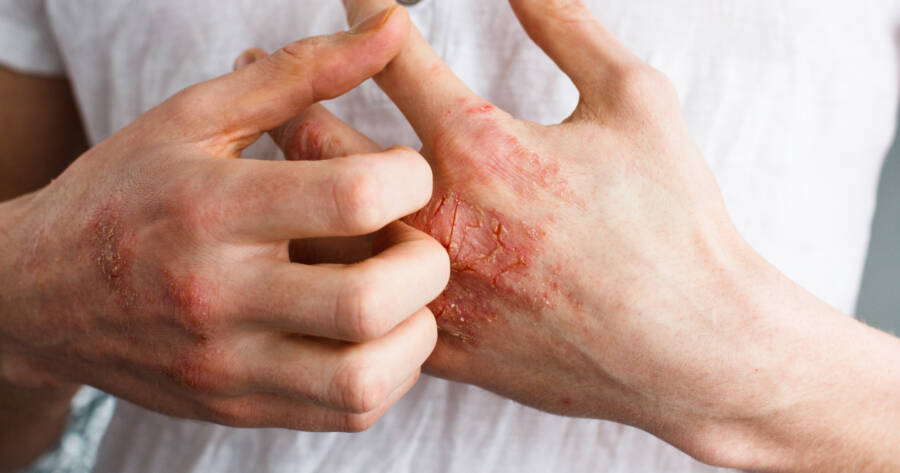Atopic dermatitis is a chronic skin condition characterized by red, itchy rashes that affect millions. Given how the symptoms of atopic dermatitis can often be misdiagnosed, it’s helpful to research this information online before consulting a doctor.
Often appearing in childhood, its symptoms can persist into adulthood. The condition’s cause involves a complex interplay between genetics, environmental factors, and a malfunction in the skin barrier.
What is Atopic Dermatitis?
Atopic dermatitis is a prevalent form of eczema, known for causing itchy, red patches, often appearing on facial areas, arms, and legs. It’s frequent among kids but also affects about 18 million adults.
The rashes typically cycle, flaring up and then subsiding, sometimes recurring later. This condition leads to significant discomfort, often due to the persistent itching and the recurrent nature of the rash.
Most Common Signs of Atopic Dermatitis
Atopic dermatitis is a condition marked by diverse symptoms, from mild to severe. Dry skin, intense itching, and skin swelling are common indicators. Rashes vary in color from red to brown, sometimes including fluid-filled bumps and crusting.1
Additionally, cracked skin can occur due to the intense dryness and inflammation associated with atopic dermatitis. These symptoms, while common, can appear differently in each person affected by this condition.
Warning Signs in Infants and Children
Atopic dermatitis shows distinct warning signs in infants and children, varying with age. In babies, the red, oozing rash frequently appears on the face, scalp, and joint areas. However, it rarely affects the diaper area.
In children, aged 2 years to puberty, the rash usually thickens and appears in elbow and knee bends, the neck, and ankles, accompanied by oozing and even bleeding when scratched. Recognizing these patterns assists in early detection and appropriate management of atopic dermatitis in young ones.
Additional Symptoms
Atopic dermatitis often presents distinctive skin features like Dennie-Morgan folds under the eyes, darkened skin below the eyes, and extra skin creases on the hands and feet. Individuals with this condition might also contend with other health concerns, such as asthma, allergies—including food allergies—additional skin conditions like ichthyosis, and an increased risk of experiencing depression, anxiety, and sleep disturbances.2
Recognizing these associated symptoms broadens awareness of the multifaceted impact of atopic dermatitis and the potential holistic treatment needs for affected individuals.
Who Does it Affect?
Atopic dermatitis can affect anyone at any age, though it’s most prevalent among children. It doesn’t discriminate by gender, occurring equally among individuals. While it affects people of all races, Black individuals have a slightly higher likelihood compared to White individuals.
Most cases surface early, with 65% experiencing it within the first year and 90% before age 5. Around one in ten babies or young children develop symptoms, and two-thirds continue to experience flare-ups into adulthood.3
Triggers to Be Aware Of
Atopic dermatitis can be triggered by a range of factors. When your skin’s natural barrier is weakened, it becomes more sensitive to environmental elements and allergens, which can provoke symptoms known as contact dermatitis.
Foods like peanuts, tree nuts, eggs, soy, cow’s milk, wheat, shellfish, and seafood are among the primary triggers for atopic dermatitis symptoms. These elements can spark skin reactions, leading to itching, redness, and other symptoms.
Treatment Approaches for Atopic Dermatitis
Treatment strategies for atopic dermatitis often commence with basic self-care practices, like frequent moisturizing. If these don’t alleviate symptoms, medicated creams or ointments may be recommended to curb itching and rejuvenate the skin.
Persistent conditions might require different treatments experimented with over months or years. Some involve medicated skin products, such as corticosteroids or calcineurin inhibitors. For severe cases, a range of treatments might be suggested, from antibiotics for infections to pills that control inflammation. Other specialized options, include injectable biologics, or non-drug therapies like wet dressings or light therapy.
Prevention Tips and Lifestyle Management
Developing a consistent skin care routine can play a crucial role in preventing eczema flares. Simple practices can help manage symptoms: moisturizing the skin at least twice daily with unscented products, opting for gentle, non-soap cleansers, and patting the skin dry after bathing to retain moisture.
For babies, using petroleum jelly could prevent the development of atopic dermatitis. Identifying and avoiding personal triggers, such as known irritants, is key. Items that provoke itching should be avoided, as scratching often results in flares.
Learn More About Atopic Dermatitis Today!
Atopic dermatitis can be a persistent, uncomfortable condition, but with proper management and a deeper understanding of its signs and treatment strategies, individuals can significantly improve their quality of life.
Understanding the signs and symptoms allows for early intervention and a more proactive approach to its management, potentially minimizing the impact of this chronic skin condition. Exploring more online resources on atopic dermatitis can offer additional strategies and insights into effective management techniques.




